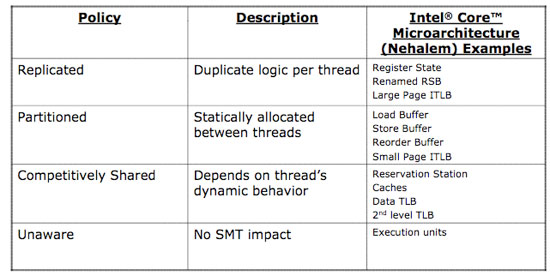The Dark Knight: Intel's Core i7
by Anand Lal Shimpi & Gary Key on November 3, 2008 12:00 AM EST- Posted in
- CPUs
Thread It Like Its Hot
Hyper Threading was a great technology, simply first introduced on the wrong processor. The execution units of any modern day microprocessor are power hungry and consume a lot of die space, the last thing you want is to have them be idle with nothing to do. So you implement various tricks to keep them fed and working as often as possible. You increase cache sizes to make sure they never have to wait on main memory, you integrate a memory controller to ensure that trips to main memory are as speedy as possible, you prefetch data that you think you'll need in the future, you predict branches, etc...
Enabling simultaneous multi-threaded (SMT) execution is one of the most power efficient uses of a microprocessor's transistor budget, as it requires a very minimal increase in die size but can easily double the utilization of a CPU's execution units. SMT, or as Intel calls it, Hyper Threading does this by simply dispatching two threads of instructions to an individual processor core at the same time without increasing the available execution resources. Parallelism is paramount to extracting peak performance out of any out of order core, double the number of instructions being looked at to extract parallelism from and you increase your likelihood of getting work done without waiting on other instructions to retire or data to come back from memory.
In the Pentium 4 days enabling Hyper Threading required less than a 5% increase in die size but resulted in anywhere from a 0 - 35% increase in performance. On the desktop we rarely saw a big boost in performance except in multitasking scenarios, but these days multithreaded software is far more common than it was six years ago when Hyper Threading first made its debut.

This table shows what needed to be added, partitioned, shared or unchanged to enable Hyper Threading on Intel's Core microarchitecture
When the Pentium 4 made its debut however all we really had to worry about was die size, power consumption had yet to become a big issue (which the P4 promptly changed). These days power efficiency, die size and performance all go hand in hand and thus the benefits of Hyper Threading must also be looked at from the power perspective.
I took a small sampling of benchmarks ranging from things like POV-Ray which scales very well with more threads to iTunes, an application that couldn't care less if you had more than two cores. What we're looking at here are the performance and power impact due to Hyper Threading:
| Intel Core i7-965 (Nehalem 3.2GHz) | POV-Ray 3.7 Beta 29 | Cinebench R10 1CPU | Race Driver GRID | |||
| HT Disabled | 3239 PPS | 207W | 4671 CBMarks | 161.8W | 103 fps | 300.7W |
| HT Enabled | 4202 PPS | 233.7W | 4452 CBMarks | 159.5W | 102.9 fps | 302W |
Looking at POV-Ray we see a 30% increase in performance for a 12% increase in total system power consumption, that more than exceeds Intel's 2:1 rule for performance improvement vs. increase in power consumption. The single threaded Cinebench test shows a slight decrease in both performance and power consumption (negligible) and the same can be said for Race Driver GRID.
When Hyper Threading improves performance, it does so at a reasonable increase in power consumption. When performance isn't impacted, neither is power consumption. This time around Hyper Threading has no drawbacks, while before the only way to get it was with a processor that was too hot and barely competitive, today Intel offers it on an architecture that we actually like. Hyper Threading is actually the first indication of Nehalem's true strength, not performance, but rather power efficiency...










73 Comments
View All Comments
fzkl - Monday, November 3, 2008 - link
"Where Nehalem really succeeds however is in anything involving video encoding or 3D rendering"We have new CPU that does Video encoding and 3D Rendering really well while at the same time the GPU manufacturers are offloading these applications to the GPU.
The CPU Vs GPU debate heats up more.
_______________________________________________________________
www.topicbean.com
Griswold - Tuesday, November 4, 2008 - link
Wheres the product that offloads encoding to GPUs - all of them, from both makers - as a publicly available product? I havent seen that yet. Of course, we havent seen Core i7 in the wild yet either, but I bet it will be many moons before there is that single encoding suite that is ready for primetime regardless of the card that is sitting in your machine. On the other hand, I can encode my stuff right now with my current Intel or AMD products and will just move them over to the upcoming products without having to think about it.Huge difference. The debate isnt really a debate yet, if you're doing more than just talking about it.
haukionkannel - Monday, November 3, 2008 - link
Well if both CPU and GPU are better for video encoding, the better! Even now the rendering takes forever.So there is not any problem if GPU helps allready good 3d render CPU. Everything that gives more speed is just bonus!